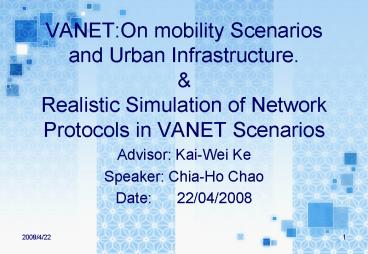VANET:On mobility Scenarios and Urban Infrastructure. - PowerPoint PPT Presentation
1 / 41
Title:
VANET:On mobility Scenarios and Urban Infrastructure.
Description:
VANET:On mobility Scenarios and Urban Infrastructure. & Realistic Simulation of Network Protocols in VANET Scenarios Advisor: Kai-Wei Ke Speaker: Chia-Ho Chao – PowerPoint PPT presentation
Number of Views:252
Avg rating:3.0/5.0
Title: VANET:On mobility Scenarios and Urban Infrastructure.
1
VANETOn mobility Scenarios and Urban
Infrastructure.Realistic Simulation of Network
Protocols in VANET Scenarios
- Advisor Kai-Wei Ke
- Speaker Chia-Ho Chao
- Date 22/04/2008
2
VANETOn mobility Scenarios and Urban
Infrastructure.
3
Outline
- Overview of TRANSIMS
- Overview of CORSIM
- Random waypoint (RWP)
- Mobility Models Comparison
- Flat Network
- Opportunistic Infrastructure
- Inter-contact Times
- Afternoon Trend
- Conclusion
4
TRANSIMS Traces
- TRANSIMS
- Transportation Analysis Simulation
- System
- Asses the performance of a large scale urban
sensor network. - Creating car movement patterns based on activity
flows by large scale, vehicular traffic and
parallel simulator.
5
CORSIM Traces
- CORSIM
- Microscopic Traffic Simulation Model
- high level of precision in vehicular traffic
simulation. - difference from TRANSIMS
- Single CPU
- Lack of activity flow information
6
RWP
7
Mobility Models ComparisonSimulation setting
8
Simulation setting
- VANET simulations are run for 200 seconds on a
12 km rectangle on the map. - Highest AP density
7AM 8AM
Average vehicles 270 371
Average speed per second 12.6 m/s 12.5 m/s
Stop time(seconds) 3.2 5.7
9
Mobility Models ComparisonFLAT NETWORK
10
Using TRANSIMS mobility traces
7am no APs
8am no APs
11
Using RWP model
7am no APs
8am no APs
12
Using CORSIM mobility traces
7am no APs
8am no APs
13
Mobility Models ComparisonOPPORTUNISTIC
INFRASTRUCTURE
14
Simulation Setting
15
Simulation Setting
16
Using TRANSIMS mobility traces
7am with APs
8am with APs
17
Using RWP model
7am with APs
8am with APs
18
Using CORSIM mobility traces
7am with APs
8am with APs
19
Mobility Models ComparisonInter-contact
TimesandAfternoon trend
20
TRANSIMS mobility traces at 7AM
21
TRANSIMS mobility traces at 8AM
22
Afternoon trend
23
Afternoon trend
24
Conclusion
- The results confirm that open APs can be
effectively exploited to dramatically improve
performance. - A correct model of traffic flows is important.
- In long timeframes during the day (i.e. rush
hours), network becomes static.
25
Realistic Simulation of Network Protocols in
VANET Scenarios
26
Outline
- Traffic Simulation
- Network Simulation
- Coupling Traffic Microsimulation and Network
Simulation - Simulation Result
- Conclusion
27
Traffic Simulation
- Macroscopic models
- METACOR
- Mesoscopic models
- CONTRAM
- Microscopic models
- Cellular Automaton model (CA)
- SK model
- IDM/MOBIL model
28
Intelligent-Driver Model(IDM)
- Car-following model
Difference in speed
Time headway
Additional gap(driving)
Minimum gap(jam)
Desired gap
acomfortable acceleration bcomfortable
deceleration
Acceleration exponent
acceleration
The gap to a vehicle in front
Desired velocity
29
MOBIL
- MOBIL
- Minimizing Overall Braking decelerations
Induced by Lane change - Have to be fulfilled two criteria
- The lane change has to be safe.
politeness factor
Lane change threshold
Desired gap
b)
Acceleration
Maximum safe deceleration
Desired gap
Bias to the right lane
30
Road Traffic Microsimulation Parameters
Car Track
Desired velocity V0 33.0m/s 22.2 m/s
Time headway T 1.5s 1.7s
Comfortable acceleration a 0.73m/s2 0.73 m/s2
Comfortable deceleration b 1.67m/s2 1.67 m/s2
Acceleration exponent 4 4
Minimum gap (jam) S0 2m 2m
Additional gap (driving) S1 0m 0m
Vehicle length l 6m 10m
Politeness factor P 20 20
Maximum safe deceleration bsave 4m/s2 4 m/s2
Lane change threshold athr 0.3 m/s2 0.2 m/s2
Bias to the right lane ?b 0.1 rm/s2 0.3 m/s2
d
31
OMNeT
- A discrete event simulation environment.
- primary application area is the simulation of
communication networks - GUI support
- INET Framework
32
DYMO Routing Protocol
- DYMO Dynamic MANET On-Demand
- Reactive
A
A
A
AB
ABC
A
B
C
D
AODV
DYMO
DCB
D
D
D
DC
33
DYMO and support modules in the protocol stack
App1
App2
DYMO
TCP.mss 1024Byte
TCP.advertisedWindow 14336Byte
TCP.tcpAlgorithmClass TCPReno
Transport Layer
queue
hook
Network Layer
ARP.retryTimeout 1s
ARP.retryCount 3
ARP.cacheTimeout 100s
mac.address auto
mac.bitrate 11Mbit/s
mac.broadcastBackoff 31slots
mac.QueueSize 14Pckts
mac.rtsCts False
Data Link Layer
34
Simulated VANET Scenario
35
Coupling Traffic Microsimulation and Network
Simulation
Car icar0_ Car icar1_ Car Icar1_
3187,1487 3187,1490 3187,1493 3187,1495 3187,1498 3187,1501 3188,1504 3171,1380 3172,1387 3173,1394 3174,1402 3175,1409 3176,1417 3177,1425 3154,1262 3156,1269 3153,1277 3155,1284 3156,1291 3158,1299 3159,1306
Excerpt from the traffic simulations output
stream
36
Simulation Result
15
37
Simulation Result
38
Simulation Result
39
Conclusion
- Integrated the traffic model in network
simulation in order to improve the quality of
network simulations. - Simulation setups using simple mobility models
often produce skewed results compared to the
application of traffic models.
40
Reference
- G. Marfia, G. Pau, E. De Sena, E. Giordano, M.
Gerla, Evaluating Vehicle Network Strategies for
Downtown Portland opportunistic infrastructure
and the importance of realistic mobility models, - http//transims.tsasa.lanl.gov/.
- http//mctrans.ce.ufl.edu/featured/TSIS/Version5/c
orsim.htm. - http//www.omnetpp.org/
- I. Dietrich, C. Sommer, and F. Dressler,
"Simulating DYMO in OMNeT," University of
Erlangen, Dept. of Computer Science 7, Technical
Report 01/07, April 2007.
41
Thanks for your attention!































